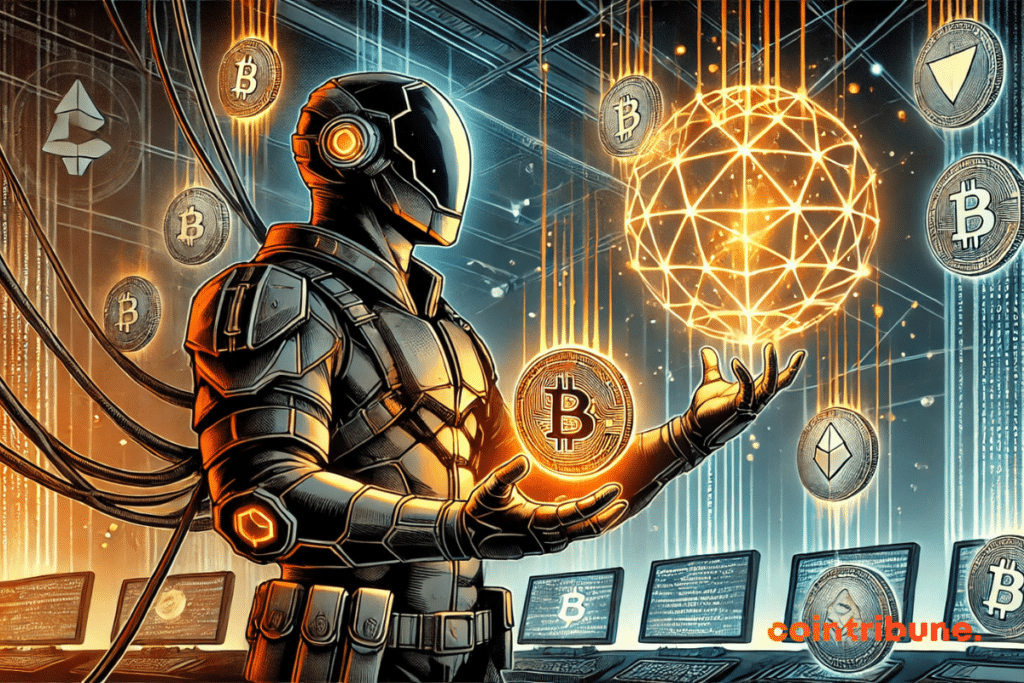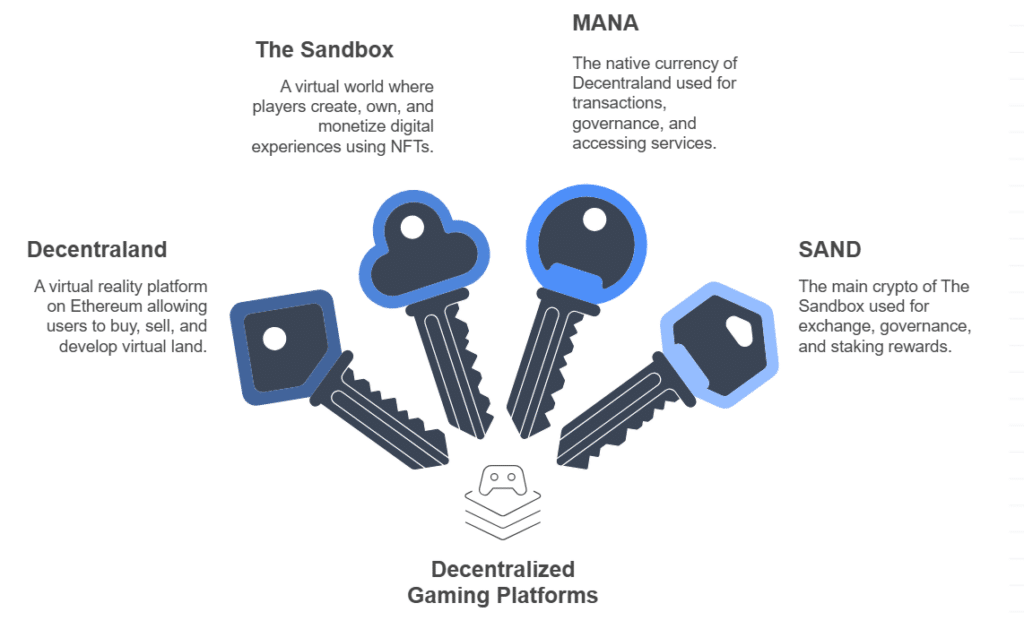What Cryptocurrencies Are Used in Web3 Gaming?
Cryptos play an important role in the functioning of Web3 gaming. They facilitate transactions, guarantee ownership of digital assets, and support new economic models. Players can securely buy, sell, or exchange virtual items thanks to blockchain technology. Each game utilizes specific cryptos to ensure its proper functioning. Some serve as governance tokens, while others enable the purchase of assets or the payment of transaction fees. This article analyzes the main cryptocurrencies used in Web3 gaming. It explores their role, their integration into games, and their impact on the evolution of the video game sector.

In brief
- Definition: cryptocurrencies in Web3 gaming are used to buy, sell, exchange, or manage digital assets, while supporting governance and the economy of games.
- Native tokens: AXS, SLP (Axie Infinity), ILV (Illuvium), MANA (Decentraland), SAND (The Sandbox) facilitate transactions and governance within their ecosystems.
- Blockchain infrastructures: Ethereum (ETH) and Solana (SOL) host smart contracts and ensure fast and secure exchanges.
- NFT Marketplaces: OpenSea (WETH) and Rarible (RARI) allow players to buy and sell game items using cryptos.
- Impact: cryptos redefine economic models in video gaming by giving players control over their assets and strengthening decentralized economies.
Native cryptos of Web3 games
Some Web3 games develop their own cryptos to manage interactions between players and ensure the internal economy. These tokens allow for the purchase of items, governance, and rewarding participants.

Axie Infinity Shards (AXS) and Smooth Love Potion (SLP)
Axie Infinity is built on the Ethereum blockchain and offers an experience based on breeding and battling digital creatures called Axies. These creatures exist as non-fungible tokens (NFTs), ensuring their uniqueness and traceability. The Vietnamese studio Sky Mavis designed this game to combine entertainment with financial gains through a Play-to-Earn model.
Axie Infinity uses two essential cryptos for its operation:
- Axie Infinity Shards (AXS): this token serves governance purposes. Holders can vote on future updates and strategic decisions for the game. It promotes community engagement and strengthens project decentralization;
- Smooth Love Potion (SLP): this utility token is generated by players when they win battles. It allows for the breeding of new Axies, thus contributing to the game dynamics and creating value for participants.
These cryptos directly influence the game’s economy. Players can exchange them on trading platforms to generate profits. This model has attracted thousands of users but also revealed limitations, particularly regarding the volatility of token prices.
Illuvium (ILV)
Illuvium is a role-playing game in an open world developed on the Ethereum blockchain. It integrates capture and combat mechanics similar to those found in classic genre games. Each creature, known as an Illuvial, has unique characteristics and is represented by an NFT. This system guarantees players true digital ownership of their creatures and equipment.
The ILV token plays a fundamental role in the game’s ecosystem. It serves several purposes:
- Player rewards: participants receive ILV by completing challenges or winning battles. This reward motivates engagement and encourages activity on the platform;
- Governance: token holders can vote on major development decisions for the game, thus influencing its evolution;
- Staking and passive income: players can lock their ILV in staking pools to receive regular returns. This feature allows investors to generate profits while supporting the project’s stability.
Illuvium stands out for its ambition to offer a triple-A gaming experience on the blockchain. Its economic model is based on true decentralization, ensuring players have total control over their digital assets.
Cryptos of decentralized gaming platforms
Decentralized gaming platforms allow players to interact in virtual worlds based on blockchain technology. They provide true digital ownership and use specific cryptos for transactions and governance.

Decentraland (MANA)
Decentraland is a virtual reality platform operating on the Ethereum blockchain. It allows users to buy, sell, and build on virtual parcels of land in the form of NFTs. Each parcel belongs to its owner and can be developed according to their preferences.
This virtual world offers varied experiences, ranging from digital art galleries to virtual casinos, as well as social and commercial spaces. Major brands and tech companies are interested in Decentraland to develop immersive experiences and provide services in a decentralized environment.
The MANA is the native currency of Decentraland. It serves several essential functions:
- Buying land and virtual items: players use MANA to acquire LAND, digital parcels they can develop or resell. This token is also used to purchase accessories, clothing for avatars, and various decorative items;
- Access to platform services: some events and private spaces require payment in MANA. Companies use this token to organize conferences, concerts, and virtual exhibitions;
- Participation in governance: MANA holders can vote on development decisions through a decentralized autonomous organization (DAO). This structure ensures an evolution based on the community’s will.
MANA plays a central role in Decentraland’s virtual economy. It fosters the creation of a dynamic marketplace where each user can invest, trade, and monetize their content.
The Sandbox (SAND)
The Sandbox is a virtual world designed to allow players to create, own, and monetize their digital experiences. It relies on the Ethereum blockchain and uses NFTs to represent land, objects, and avatars.
The ecosystem encourages the creation of interactive content through tools like Game Maker and VoxEdit. These features allow for the design of customized games and environments. The Sandbox attracts brands and celebrities like Adidas and Snoop Dogg who leverage the metaverse to provide exclusive experiences.
The SAND is the main crypto of The Sandbox. It serves several functions:
- Medium of exchange: users buy and sell land, objects, and equipment using SAND. This token is also used to compensate content creators;
- Decentralized governance: SAND holders participate in project decisions through a community voting system. They influence the direction of the platform and its future updates;
- Staking and rewards: SAND allows players to stake their tokens for passive income. This option encourages holding SAND and supports the platform’s economy.
The Sandbox aims to become an open ecosystem where every player has full control over their digital assets. Its model is based on a participatory economy, fueled by SAND and interactions between creators and users.
The cryptos of blockchain infrastructures for gaming
Blockchains ensure the smooth operation of Web3 games by facilitating the management of digital assets and the execution of transactions. They host smart contracts and enable interaction between players and decentralized applications. Ethereum and Solana are among the most used infrastructures in this field.
Ethereum (ETH)
Ethereum is the most widespread blockchain in the Web3 ecosystem. Its architecture allows developers to create smart contracts that automate the execution of game rules without intermediaries. These contracts guarantee transparency and prevent any fraudulent modification.
Ethereum introduced ERC-20 and ERC-721 token standards. The ERC-721 standard has become the norm for NFTs, which represent unique items in Web3 games. Numerous projects, such as Axie Infinity, Decentraland, and The Sandbox, rely on Ethereum to ensure the ownership of digital assets.
ETH serves several functions in Web3 games:
- Payment of transaction fees: each interaction with a smart contract incurs gas fees paid in ETH. These costs vary depending on network congestion;
- Purchase of digital assets: ETH allows for the purchase of NFTs, utility tokens, and virtual items on marketplaces like OpenSea;
- Participation in governance: Some games integrate voting systems based on ETH, giving players a decision-making right on the evolution of the project.
Ethereum remains an essential reference but suffers from high fees and slowdowns due to its high adoption. These limitations push some Web3 games to explore alternative solutions, such as alternative blockchains.
Solana (SOL)
Solana is a blockchain designed to offer fast and low-cost transactions. Unlike Ethereum, it uses a consensus mechanism combining Proof-of-Stake (PoS) and Proof-of-History (PoH). This approach allows for high scalability with reduced validation times.
Thanks to this performance, Solana attracts many Web3 game developers. It supports smart contracts, NFTs, and decentralized applications (dApps) while ensuring minimal fees. Games like Star Atlas and Aurory use this blockchain to provide a smooth and immersive experience.
The SOL, Solana’s native token, plays a key role in Web3 games:
- Execution of smart contracts: games use SOL to deploy and operate their smart contracts, necessary for asset exchanges and in-game interactions;
- Low-cost transactions: users pay negligible fees in SOL when buying, selling, or transferring NFTs and tokens;
- Network security: SOL holders can stake their tokens to support the network and earn rewards.
Solana positions itself as a fast and accessible alternative to Ethereum. Its low cost and speed attract more and more Web3 games looking to offer a smooth experience to players.
The cryptos of NFT marketplaces
NFT marketplaces allow players and collectors to exchange their digital assets transparently. These platforms use specific cryptos to ensure transactions and governance. OpenSea and Rarible are among the market leaders.

OpenSea and the WETH token
OpenSea is the largest NFT marketplace operating on the Ethereum blockchain. It allows users to buy, sell, and trade non-fungible tokens (NFTs) representing digital artworks, game items, and virtual land.
Launched in 2017, OpenSea supports several token standards, such as ERC-721 and ERC-1155, guaranteeing interoperability between different projects. Many Web3 games, such as Decentraland, The Sandbox, and Axie Infinity, use OpenSea to host their NFTs and facilitate exchanges between players.
The WETH (Wrapped Ether) is the main crypto used on OpenSea. It represents a wrapped version of ETH, compatible with the ERC-20 standard, improving its usability on the platform.
WETH allows for several actions:
- Facilitation of transactions: buyers and sellers use WETH to make instant transactions without converting back to ETH;
- Participation in auctions: OpenSea offers an auction system where users place their bids in WETH without locking their funds;
- Interoperability with other Web3 applications: WETH operates on multiple DeFi protocols and NFT marketplaces, ensuring better flexibility.
WETH enhances the user experience on OpenSea by reducing transaction frictions and facilitating the buying and selling of digital assets.
Rarible and the RARI token
Rarible is a decentralized NFT marketplace that allows users to create, buy, and sell NFTs without intermediaries. Unlike OpenSea, Rarible focuses on creating digital content and gives more power to artists and developers.
This platform operates on Ethereum and supports various types of NFTs, particularly for Web3 games, digital art, and collectibles. It promotes a community model where users directly influence platform developments.
RARI is the native token of Rarible. It serves several essential functions:
- Decentralized governance: RARI holders participate in platform decisions through a community voting system. They influence future updates and marketplace policies;
- Rewards for active users: Rarible distributes RARI to the most active buyers and sellers. This incentive encourages trading and user retention;
- Encouragement of content creation: artists and developers receive RARI when they publish or sell NFTs on the platform.
Rarible’s governance model aims to enhance user autonomy and ensure a dynamic and fair marketplace. With RARI, the community directly influences the platform’s evolution, fostering innovation and the adoption of NFTs in Web3 gaming.
Cryptos are revolutionizing Web3 gaming by introducing decentralized economic models. They allow players to own, trade, and monetize their digital assets without relying on a centralized publisher. Tokens facilitate transactions, governance, and engagement within communities. The integration of cryptos into Web3 games transforms the video game industry. Developers explore new opportunities to enhance player experience and create dynamic virtual universes. The evolution of blockchain infrastructures and the gradual adoption of these technologies shape the future of decentralized gaming.
FAQ
No, each game uses specific cryptocurrencies with distinct roles. Some act as in-game currency, others as governance tokens, and their interchangeability depends on available platforms and blockchain bridges.
Yes, some games offer free modes or trial versions, but the full experience often requires purchasing crypto or NFTs. Solutions like fiat payment options are being developed to improve accessibility.
Yes, gaming cryptocurrencies experience price fluctuations based on supply and demand. This volatility can affect game economies and the value of assets held by players.
Maximize your Cointribune experience with our "Read to Earn" program! For every article you read, earn points and access exclusive rewards. Sign up now and start earning benefits.
Diplômé de Sciences Po Toulouse et titulaire d'une certification consultant blockchain délivrée par Alyra, j'ai rejoint l'aventure Cointribune en 2019. Convaincu du potentiel de la blockchain pour transformer de nombreux secteurs de l'économie, j'ai pris l'engagement de sensibiliser et d'informer le grand public sur cet écosystème en constante évolution. Mon objectif est de permettre à chacun de mieux comprendre la blockchain et de saisir les opportunités qu'elle offre. Je m'efforce chaque jour de fournir une analyse objective de l'actualité, de décrypter les tendances du marché, de relayer les dernières innovations technologiques et de mettre en perspective les enjeux économiques et sociétaux de cette révolution en marche.
The views, thoughts, and opinions expressed in this article belong solely to the author, and should not be taken as investment advice. Do your own research before taking any investment decisions.